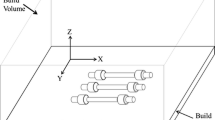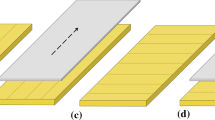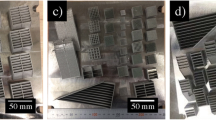Abstract
We conducted an experimental and analytical study to understand the mechanisms and dominant parameters for ogive-nose rods and 7.62 mm APM2 bullets that perforate 5083-H116 aluminum armor plates. The 20-mm-diameter, 95-mm-long, ogive-nose, 197 g, hard steel rods were launched with a gas gun to striking velocities between 230–370 m/s. The 7.62-mm-diameter, 10.7 g, APM2 bullet consists of a brass jacket, lead filler, and a 5.25 g, ogive-nose, hard steel core. The brass and lead were stripped from the APM2 bullets by the targets, so we conducted ballistic experiments with both the APM2 bullets and only the hard steel cores. These projectiles were fired from a rifle to striking velocities between 480–950 m/s. Targets were 20, 40, and 60-mm-thick, where the 40 and 60-mm-thick targets were made up of layered 20-mm-thick plates in contact with each other. The measured ballistic-limit velocities for the APM2 bullets were 4, 6, and 12% smaller than that for the hard steel cores for the 20, 40, and 60-mm-thick targets, respectively. Thus, the brass jacket and lead filler had a relatively small effect on the perforation process. In addition, we conducted large strain, compression tests on the 5083-H116 aluminum plate material for input to perforation equations derived from a cavity-expansion model for the ogive-nose rods and steel core projectiles. Predictions for the rod and hard steel core projectiles are shown to be in good agreement with measured ballistic-limit and residual velocity data. These experimental results and perforation equations display the dominant problem parameters.











Similar content being viewed by others
References
Forrestal MJ, Warren TL (2009) Perforation equations for conical and ogival nose rigid projectiles into aluminum target plates. Int J Impact Eng 36:220–225
Børvik T, Forrestal MJ, Hopperstad OS, Warren TL, Langseth M (2009) Perforation of AA5083–H116 aluminum plates with conical-nose steel projectiles–calculations. Int J Impact Eng 36:426–437
Dey S, Børvik T, Teng X, Wierzbicki T, Hopperstad OS (2007) On the ballistic resistance of double-layered steel plates: an experimental and numerical investigation. Int J Solids Struct 44:6701–6723
Gooch WA, Burkins MS, Squillacioti RJ (2007) Ballistic testing of commercial aluminum alloys and alternative processing techniques to increase the availability of aluminum armor. Proceedings of the 23rd International Symposium on Ballistics, Spain, pp 981–988
Anderson CE, Burkins MS, Walker JD, Gooch WA (2005) Time-resolved penetration of B4C tiles by the APM2 bullet. Comp Mod Eng Sci 8(2):91–104
Børvik T, Dey S, Clausen AH (2009) Perforation resistance of five different high-strength steel plates subjected to small-arms projectiles. Int J Impact Eng 36:948–964
Børvik T, Hopperstad OS, Berstad T, Langseth M (2001) A computational model of viscoplasticity and ductile damage for impact and penetration. European Journal of Mechanics – A/Solids 20:685-–712
Børvik T, Hopperstad OS, Langseth M, Malo KA (2003) Effect of target thickness in blunt projectile penetration of Weldox 460 E steel plates. International Journal of Impact Engineering 28:413–464
Dowling NE (1998) Mechanical behavior of materials. Second Edition, Prentice Hall, Upper Saddle River, NJ 07458: 64–65.
Clausen AH, Børvik T, Hopperstad OS, Benallal A (2004) Flow and fracture characteristics of aluminum alloy AA5083–H116 as function of strain rate, temperature and triaxiality. Materials Science and Engineering A 365:260–272
Benallal A, Berstad T, Børvik T, Clausen AH, Hopperstad OS (2006) Dynamic strain aging and related instabilities: experimental, theoretical and numerical aspects. European Journal of Mechanics – A/Solid 25:397–424
US Army Research Laboratory (2007) Military Specifications MIL-DTL-46027 K (MR). Armor plate, aluminum alloy, weldability 5083, 5456, and 5059. AMSRL-WM-MA, US Army Research Laboratory, issued 31 July 2007.
ASM International (1990) Metals handbook, tenth edition, Vol. 2 Properties and Selection: Non Ferrous Alloys and Special-Purpose Materials, Table 8.
Kawahara W (1986) Compression materials testing at low to medium strain rates. Paper no. 86-WA-Mats-15, presented at the ASME Winter Annual Meeting, Anaheim, CA.
Chen W, Skube S (2009) An experimental technique to obtain large strain compression data. Work in progress.
Forrestal MJ, Romero LA (2007) Comment on “Perforation of aluminum plates with ogive-nose steel rods at normal and oblique impacts.” Int J Impact Eng 34:1962–1964
Press WH, Flannery BP, Teukolsky SA, Vetterling WT (1990) Numerical recipes. Cambridge University Press, NY
Recht RF, Ipsen TW (1963) Ballistic perforation dynamics. ASME J Appl Mech 30:384–390
Lambert JP, Jonas GH (1976) Towards standardization in terminal ballistic testing: velocity representation. Ballistic Research Laboratories, Report BRL-R-1852, USA.
Zukas JA (1990) High velocity impact dynamics. Wiley, New York, pp 424–427
Acknowledgement
The financial support of this work from the Structural Impact Laboratory (SIMLab), Centre for Research-based Innovation (CRI) at the Norwegian University of Science and Technology (NTNU), is gratefully acknowledged.
Author information
Authors and Affiliations
Corresponding author
Appendix: Perforation Models
Appendix: Perforation Models
We give a full discussion of the cylindrical, cavity-expansion, perforation models in [1]. Briefly, the aluminum plate deformations are dominated by ductile hole-growth and the holes had nearly the diameter of the projectile shanks. To approximate ductile hole growth, the cylindrical, cavity-expansion method idealizes the target as thin independent layers that are compressed normal to the perforation direction. Thus, the analysis is simplified to one-dimensional motion in the radial plate dimension for an elastic-plastic material. We perform a cylindrically symmetric, cavity-expansion analysis, use these results to develop the perforation equations, and obtain closed-form perforation equations that predict the ballistic-limit and residual velocities.
A cylindrically symmetric cavity is expanded from zero initial radius at constant expansion velocity V. This expansion produces an elastic-plastic response. The elastic region has Young’s modulus E and Poisson’s ratio ν, and the plastic response region is taken as an incompressible, power-law hardening material. Data from uniaxial compression tests were curve fit with equations (2a,b) and results are shown in Fig. 2.
Our perforation models require the radial stress σ r at the cavity surface versus cavity-expansion velocity V. From [1]
where σ s is the quasi-static radial stress required to open the cylindrical cavity and ρ t is the target density. As discussed in [16], the integral in equation (3b) is improper because of the integrand behavior near x = 0. However, this singularity is integrable and the integral can be evaluated with an open formula such as the extended midpoint rule [17].
As discussed in [1], we accurately approximate equations (3c–e) with
where B 0 is a dimensionless constant obtained from curve-fitting equations (3c–e). The approximation given by equation (4) is required to obtain closed-form perforation equations because α and B 0 depend on V. Figure 6 shows the dimensionless radial stress at the cavity surface versus dimensionless cavity-expansion velocity from equations (3c–e) and equation (4) with B 0 = 3.105.
We now present closed-form perforation equations for rigid, ogive-nose projectiles that perforate aluminum target plates. For an ogive-nose projectile with striking velocity V s , the ballistic-limit V bl and residual velocity V r are given by
In equations (5–8), the ogive-nose rod projectile has density ρ p, shank length L, nose length l, diameter 2a, caliber-radius-head ψ, and k 1 is given by equation (1b). The target plate has density ρ t , thickness h, σ s is given by equation (3b), and B 0 is given by equation (4).
As explained in [1], the terms in C in equations (5) and (6) come from a power-series expansion that is truncated after three terms. For the applications in [1] and this study, C is small enough that the next terms are negligible. For some applications [1], the value of C is very small compared to unity and equation (6) for residual reduces to
Based on the conservation laws and some assumptions, Recht and Ipsen [18] published equation (9) as an analytical model. They then determined V bl experimentally and found that equation (9) could accurately predict V r for many data sets. Later, Lambert and Jonas [19, 20] observed that a modification of equation (9) provided a better fit to some experimental data. The Lambert-Jonas empirical equation is given by
where p is the empirical constant used to best fit the data with the least squares method. Equation (10) reduces to equation (9) for p = 2. In this study and a previous study [6], we use equation (10) to curve-fit the residual velocity versus striking velocity data.
Rights and permissions
About this article
Cite this article
Børvik, T., Forrestal, M.J. & Warren, T.L. Perforation of 5083-H116 Aluminum Armor Plates with Ogive-Nose Rods and 7.62 mm APM2 Bullets. Exp Mech 50, 969–978 (2010). https://doi.org/10.1007/s11340-009-9262-5
Received:
Accepted:
Published:
Issue Date:
DOI: https://doi.org/10.1007/s11340-009-9262-5




